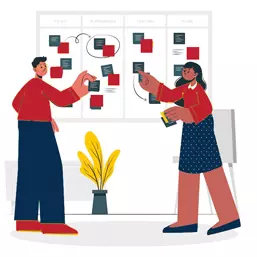
Guidelines for Effective Business Writing Collaboration
Start out with an ideal and end up with a deal.
– Karl Albrecht
Introduction
It is impossible to complete collaborative writing without a well-structured project, regardless of how talented the team members may be. When a detailed framework or guide for the project has been developed and is being utilized as a point of reference for all participants, collaborative writing is at its most successful. The group will be considerably more prepared to work once the various duties, such as appointing the group leader and clarifying team roles, have been performed. Additionally, they will be aware of what is expected of them.
Determine Purpose
Find out what you want to accomplish with the project before you start working together on it. The queries “Why are we doing this?” and “What’s the point?” are among the most frequent ones that a leader is likely to be asked. After the members of the collaboration team have been brought together, it is in everyone’s best interest to hold some kind of group meeting at which the objectives of the project and each participant’s part in achieving those objectives can be discussed.

Take use of this opportunity to describe the purpose of the group as well as the specific goals that you expect to achieve throughout the duration of the project. The purpose of the introductory meeting is to make certain that everyone is aware of the purpose of the project and that everyone will have the same goals and purposes in mind moving forward with the project. It is preferable to get everyone on the same page right from the beginning rather than try to create a consensus after the ball has already begun rolling.
Create an outline as well as an organisational format
The members of a team are able to proceed with outlining and arranging a collaborative project once it has been presented to them and they are aware of the tasks that need to be completed as part of the project. Establish which aspects of the project are most important, then draw up a plan for how they all fit together.
Although this is not the stage in which to assign tasks and responsibilities, it is acceptable to introduce members of the team to the area in which they may be working and to prepare them to become more knowledgeable about it at a later level. When you have the structure and the concept figured out, the next step is to establish any standards for things such as headings, titles, and general rules for the format. Explain to the group that while it is acceptable to deviate from the outline in some small way, the structure is rigid and will need to be followed as closely as possible in order for the group to work in a way that is both effective and easy to follow.
Brief check
Allowing suggestions from multiple perspectives are ideal for the project since it considers its broad audience. Open dialogue develops a product that considers the audience, a basic rule in technical writing.

When Selecting a Leader for Your Team, Keep the Following in Mind...
Before the team can be broken up into separate job areas and duties, there must first be a team leader who is in charge of managing the entire group and keeping an eye on everything that goes on inside it. When you address the group and introduce the person who will be leading the team, make sure to outline the roles and responsibilities that will fall under this leader’s purview.
In many situations, the person who is in charge of leading the team is not necessarily the person who has the most power over the other members of the team or the ability to make decisions on their own. However, this person is the one who is responsible for organizing the project, helping the team make progress, and helping to coordinate the activities and responsibilities of the team members. Common responsibilities of a team leader include: keeping the project moving forward over time; defining tasks and responsibilities for other members of the team; enforcing deadlines and maintaining group communication; helping to manage conflicts and disagreements; and
Assign Writing Responsibilities as well as Other Duties
One of the last processes in setting up the cooperation group is to determine what writing activities need to be finished, as well as which employees will be given responsibility for completing those writing assignments. When delegating tasks, it is important to keep in mind the skills and areas of specialization that each member of the team possesses, in addition to any prior experience they may have had in the relevant industry. It is also not unheard of to give some of the more difficult or complex tasks to individuals with a greater amount of experience.

Brief check
Collaborative writing allows employees, both new and experienced, to test their abilities as both leaders and subordinate team members.
Determine who among the writing crew will be in charge of writing the content, as well as whether or not they will have separate editors to assist them. If the project is more extensive, it is possible that each writer may need to be assigned a unique chunk of the work. Don’t forget to assign any other various duties needed to the staff members who are not directly involved in the writing portion, such as conducting research, gathering information from a variety of sources, distributing/making copies, or producing document samples. These are just some examples of the types of tasks that could be assigned. When members of the team are informed in advance of the role that they will play in the project, they are more likely to appreciate the significance of their contribution, which in turn makes them more willing to take part in the endeavor.
Practical Application
Daniel was given the responsibility of managing his first collaboration group today. Because he was concerned about his ability to successfully manage the team, he conferred with Sherry, his manager, and received some sound guidance. Daniel explained to his manager the objective of the task, and he had a general idea of the areas that needed to be improved upon before he met with the management.
Sherry proposed that Daniel designate particular responsibilities and tasks to certain members of the team so that those individuals may become acquainted with the function that they play in the project. Daniel called a meeting of his team in order to brief them on the project after he had completed the planning and organizing stages of the endeavor.





